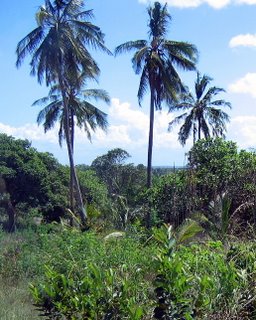I spent Tuesday through Thursday last week in a tiny village called Chikonji, northwest of Lindi. People here say it’s in the jungle (mwitu) but it doesn’t jive with most Americans’ stereotypical jungle imagery. Neither is it really like the African bush you see in movies or National Geographic. Near the ocean, mangrove swamps and palms predominate, but upland as in places like Chikonji, all you see are fruit trees—coconut palms, mangoes, and cashews.

My prior knowledge of cashews was limited to the fact that they are the really good nuts I try to eat first in those cans of fancy mixed nuts. Really they are the seed that dangles from a completely bizarre fruit. Below is a picture of cashew fruits; the familiar part of the cashew we snack on after a good roast and a liberal application of salt is inside the seed pod hanging off the fruit.

When ripe, the fruit and the seed pod fall to the ground together and are harvested. The fruit is set aside and used to brew local beer (haven’t had it yet but I’m sure it’s memorable, as most local brews are!). The pods are washed and popped open with a knife to expose the cashew nut, and then the cashews are roasted over a fire. In the village, this means they get a few nice brown spots here and there, but also a richer flavor. Even after roasting, they have a papery coating like peanuts do. Below is a picture of moshi wa korosho (cashew smoke during roasting):

For better or worse, the crop price for cashews is controlled by the Tanzanian government. It’s big business: here in Mtwara, one of the biggest government offices in town is the Bodi ya Korosho (Cashew Board). Yesterday, I saw a huge cargo ship in Mtwara Harbor, presumably laden with cashews, and likely bound for India, where most of the Tanzanian cashew crop is roasted, salted, and packaged—by hand, mind you, as it’s a way to employ many people—for happy hours worldwide. Recently there has been some debate in the papers about the government-set cashew price for this year, because apparently there is pressure from buyers for lower prices. Obviously, lower prices would hurt the cashew farmers, who rely on the cashew crop revenue to invest in fertilizers and supplies for next year, not to mention food to live on until then. With all the transoceanic travel these cashews do, it’s no wonder they’re stratospherically expensive. Still, I suspect the middlemen and the shipping companies clean up compared to the poor farmers who live here and do the lion’s share of the work.
Sadly, cashews are often blamed for recent seasonal spikes in crime in this sleepy town (Mtwara). Where there are international buyers, there are noticeable influxes of foreign money, which lures opportunistic thieves from other regions in Tanzania and Mozambique. Petty theft and break-ins surge during the cashew harvest season. It’s really a shame, as from what I’ve seen, Mtwara is known for being peaceful and bucolic.
No comments:
Post a Comment